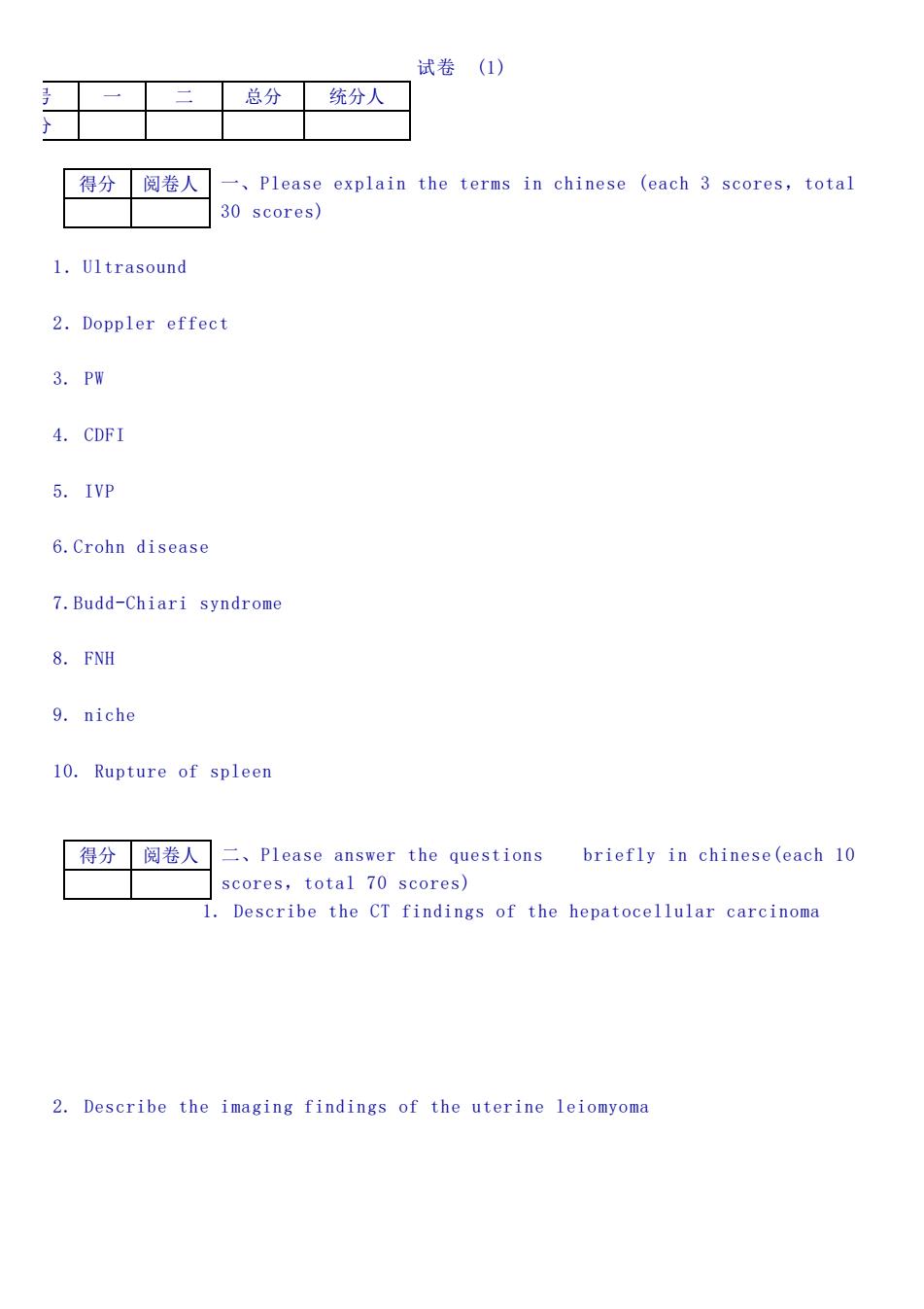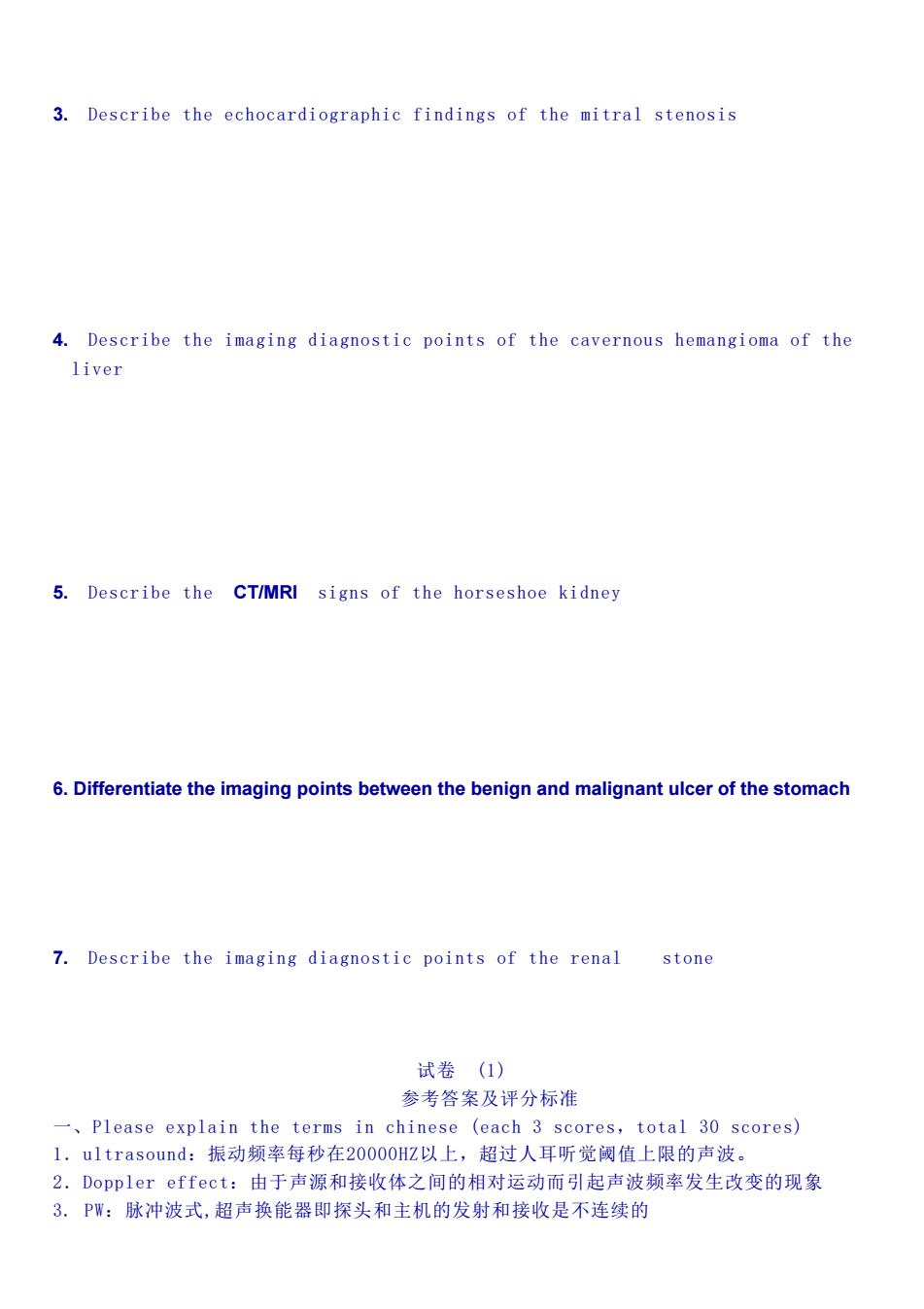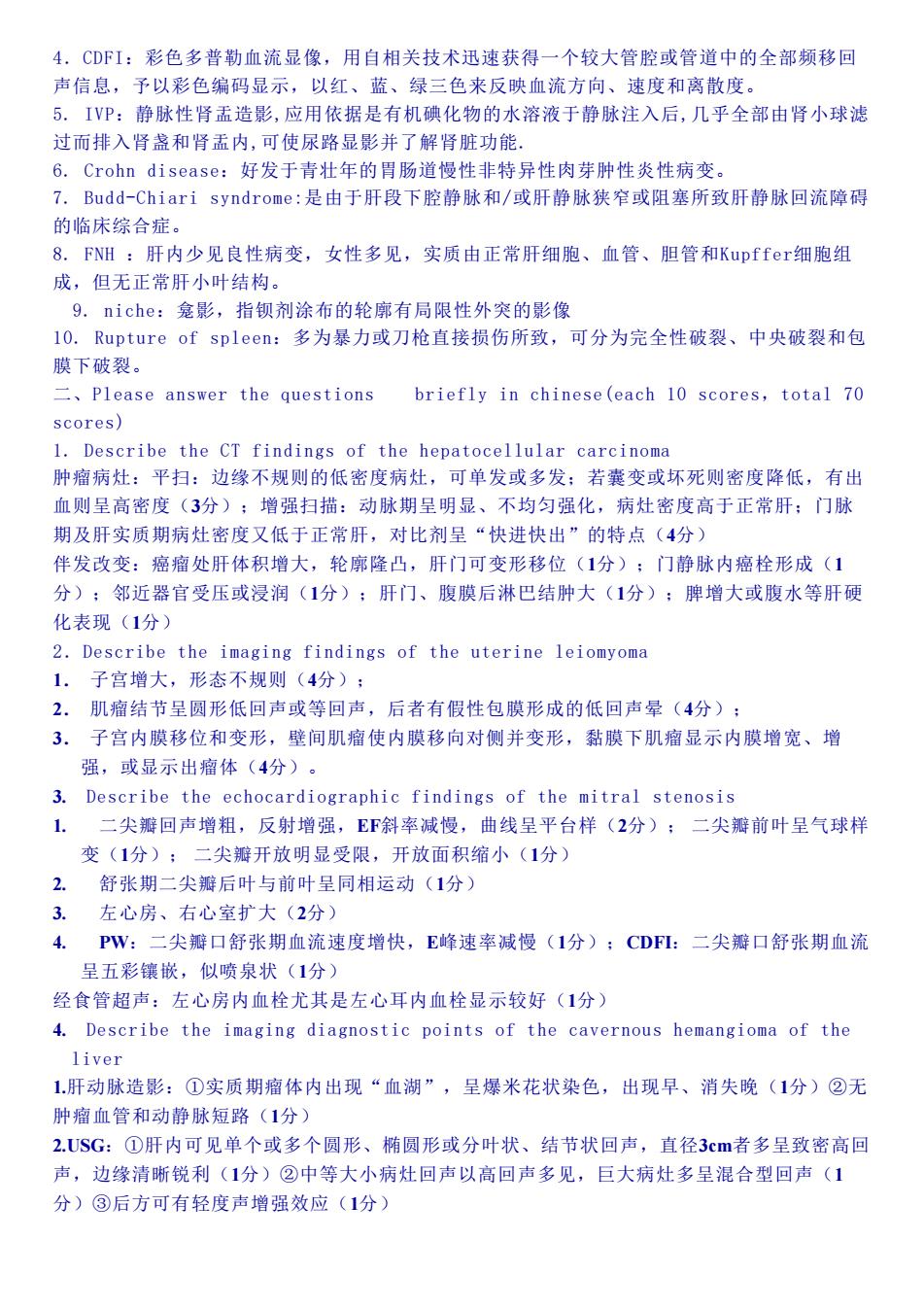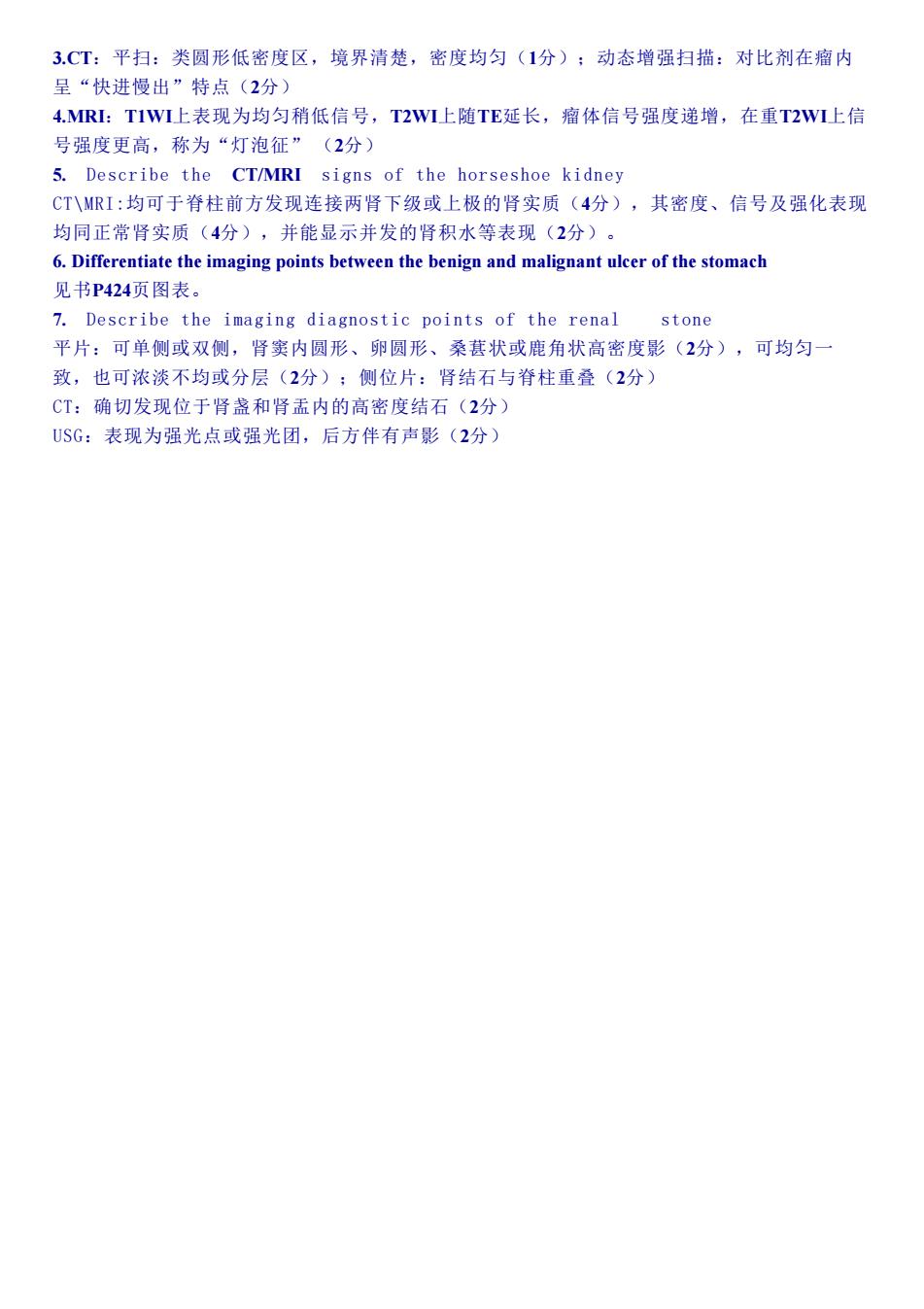
试卷(1) 总分统分人 得分阅卷人 -,Please explain the terms in chinese (each 3 scores,total 30 scores) 1.Ultrasound 2.Doppler effect 3.PW 4.CDFI 5.IVP 6.Crohn disease 7.Budd-Chiari syndrome 8.FNH 9.niche 10.Rupture of spleen 得分阅卷人二、Please answer the questions briefly in chinese(each 10 scores,total 70 scores) 1.Describe the CT findings of the hepatocellular carcinoma 2.Describe the imaging findings of the uterine leiomyoma
得分 阅卷人 得分 阅卷人 试卷 (1) 号 一 二 总分 统分人 分 一、Please explain the terms in chinese (each 3 scores,total 30 scores) 1.Ultrasound 2.Doppler effect 3. PW 4. CDFI 5. IVP 6.Crohn disease 7.Budd-Chiari syndrome 8. FNH 9. niche 10. Rupture of spleen 二、Please answer the questions briefly in chinese(each 10 scores,total 70 scores) 1. Describe the CT findings of the hepatocellular carcinoma 2. Describe the imaging findings of the uterine leiomyoma

3.Describe the echocardiographic findings of the mitral stenosis 4.Describe the imaging diagnostic points of the cavernous hemangioma of the liver 5.Describe the CT/MRI signs of the horseshoe kidney 6.Differentiate the imaging points between the benign and malignant ulcer of the stomach 7.Describe the imaging diagnostic points of the renal stone 试卷(1) 参考答案及评分标准 -Please explain the terms in chinese (each 3 scores,total 30 scores) 1.ultrasound:振动频率每秒在20000HZ以上,超过人耳听觉阙值上限的声波。 2.Doppler effect:由于声源和接收体之间的相对运动而引起声波频率发生改变的现象 3.PW:脉冲波式,超声换能器即探头和主机的发射和接收是不连续的
3. Describe the echocardiographic findings of the mitral stenosis 4. Describe the imaging diagnostic points of the cavernous hemangioma of the liver 5. Describe the CT/MRI signs of the horseshoe kidney 6. Differentiate the imaging points between the benign and malignant ulcer of the stomach 7. Describe the imaging diagnostic points of the renal stone 试卷 (1) 参考答案及评分标准 一、Please explain the terms in chinese (each 3 scores,total 30 scores) 1.ultrasound:振动频率每秒在20000HZ以上,超过人耳听觉阈值上限的声波。 2.Doppler effect:由于声源和接收体之间的相对运动而引起声波频率发生改变的现象 3. PW:脉冲波式,超声换能器即探头和主机的发射和接收是不连续的

4.CDFI:彩色多普勒血流显像,用自相关技术迅速获得一个较大管腔或管道中的全部频移回 声信息,予以彩色编码显示,以红、蓝、绿三色来反映血流方向、速度和离散度。 5.IVP:静脉性肾盂造影,应用依据是有机碘化物的水溶液于静脉注入后,几乎全部由肾小球滤 过而排入肾盏和肾盂内,可使尿路显影并了解肾脏功能。 6.Crohn disease:好发于青壮年的胃肠道慢性非特异性肉芽肿性炎性病变。 7.Budd-Chiari syndrome:是由于肝段下腔静脉和/或肝静脉狭窄或阻塞所致肝静脉回流障碍 的临床综合定。 8.FNH:肝内少见良性病变,女性多见,实质由正常肝细胞、血管、胆管和Kupffers细胞组 成,但无正常肝小叶结构 9.niche:龛影,指钡剂涂布的轮席有局限性外突的影像 I0.Rupture of spleen:多为暴力或刀枪直接损伤所致,可分为完全性破裂、中央破裂和包 膜下破裂。 二、Please answer the questions briefly in chinese(each 10 scores,total 70 scores) 1.Describe the CT findings of the hepatocellular carcinoma 肿瘤病灶:平扫:边缘不规则的低密度病灶,可单发或多发:若囊变或坏死则密度降低,有出 血则呈高密度(3分);增强扫描:动脉期呈明显、不均匀强化,病灶密度高于正常肝:门脉 期及肝实质期病灶密度又低于正常肝,对比剂呈“快进快出”的特点(4分) 伴发改变:癌瘤处肝体积增大,轮廓隆凸,肝门可变形移位(1分):门静脉内癌栓形成(1 分):邻近器官受压或浸润(1分);肝门、腹膜后淋巴结肿大(1分):脾增大或腹水等肝硬 化表现(1分) 2.Describe the imaging findings of the uterine leiomyoma 1.子宫增大,形态不规则(4分): 2.肌瘤结节呈圆形低回声或等回声,后者有假性包膜形成的低回声晕(4分): 3.子宫内膜移位和变形,壁间肌瘤使内膜移向对侧并变形,黏膜下肌瘤显示内膜增宽、增 强,或显示出瘤体(4分)。 3.Describe the echocardiographic findings of the mitral stenosis 1. 二尖瓣回声增粗,反射增强,EF斜率减慢,曲线呈平台样(2分);二尖瓣前叶呈气球样 变(1分):二尖瓣开放明显受限,开放面积缩小(1分) 2. 舒张期二尖瓣后叶与前叶呈同相运动(1分) 3. 左心房、右心室大(2分) 4.PW:二尖瓣口舒张期血流速度增快,E峰速率减慢(1分):CDFI:二尖瓣口舒张期血流 呈五彩镶嵌,似喷泉状(1分) 经食管超声:左心房内血栓尤其是左心耳内血栓显示较好(1分) 4.Describe the imaging diagnostic points of the cavernous hemangioma of the liver 1.肝动脉造影:①实质期瘤体内出现“血湖”,呈爆米花状染色,出现早、消失晚(1分)②无 肿瘤血管和动静脉短路(1分) 2.USG:①肝内可见单个或多个圆形、椭圆形或分叶状、结节状回声,直径3cm者多呈致密高回 声,边缘清晰锐利(1分)②中等大小病灶回声以高回声多见,巨大病灶多呈混合型回声(1 分)③后方可有轻度声增强效应(1分)
4.CDFI:彩色多普勒血流显像,用自相关技术迅速获得一个较大管腔或管道中的全部频移回 声信息,予以彩色编码显示,以红、蓝、绿三色来反映血流方向、速度和离散度。 5. IVP:静脉性肾盂造影,应用依据是有机碘化物的水溶液于静脉注入后,几乎全部由肾小球滤 过而排入肾盏和肾盂内,可使尿路显影并了解肾脏功能. 6. Crohn disease:好发于青壮年的胃肠道慢性非特异性肉芽肿性炎性病变。 7. Budd-Chiari syndrome:是由于肝段下腔静脉和/或肝静脉狭窄或阻塞所致肝静脉回流障碍 的临床综合症。 8. FNH :肝内少见良性病变,女性多见,实质由正常肝细胞、血管、胆管和Kupffer细胞组 成,但无正常肝小叶结构。 9. niche:龛影,指钡剂涂布的轮廓有局限性外突的影像 10. Rupture of spleen:多为暴力或刀枪直接损伤所致,可分为完全性破裂、中央破裂和包 膜下破裂。 二、Please answer the questions briefly in chinese(each 10 scores,total 70 scores) 1. Describe the CT findings of the hepatocellular carcinoma 肿瘤病灶:平扫:边缘不规则的低密度病灶,可单发或多发;若囊变或坏死则密度降低,有出 血则呈高密度(3分);增强扫描:动脉期呈明显、不均匀强化,病灶密度高于正常肝;门脉 期及肝实质期病灶密度又低于正常肝,对比剂呈“快进快出”的特点(4分) 伴发改变:癌瘤处肝体积增大,轮廓隆凸,肝门可变形移位(1分);门静脉内癌栓形成(1 分);邻近器官受压或浸润(1分);肝门、腹膜后淋巴结肿大(1分);脾增大或腹水等肝硬 化表现(1分) 2.Describe the imaging findings of the uterine leiomyoma 1. 子宫增大,形态不规则(4分); 2. 肌瘤结节呈圆形低回声或等回声,后者有假性包膜形成的低回声晕(4分); 3. 子宫内膜移位和变形,壁间肌瘤使内膜移向对侧并变形,黏膜下肌瘤显示内膜增宽、增 强,或显示出瘤体(4分)。 3. Describe the echocardiographic findings of the mitral stenosis 1. 二尖瓣回声增粗,反射增强,EF斜率减慢,曲线呈平台样(2分); 二尖瓣前叶呈气球样 变(1分); 二尖瓣开放明显受限,开放面积缩小(1分) 2. 舒张期二尖瓣后叶与前叶呈同相运动(1分) 3. 左心房、右心室扩大(2分) 4. PW:二尖瓣口舒张期血流速度增快,E峰速率减慢(1分);CDFI:二尖瓣口舒张期血流 呈五彩镶嵌,似喷泉状(1分) 经食管超声:左心房内血栓尤其是左心耳内血栓显示较好(1分) 4. Describe the imaging diagnostic points of the cavernous hemangioma of the liver 1.肝动脉造影:①实质期瘤体内出现“血湖”,呈爆米花状染色,出现早、消失晚(1分)②无 肿瘤血管和动静脉短路(1分) 2.USG:①肝内可见单个或多个圆形、椭圆形或分叶状、结节状回声,直径3cm者多呈致密高回 声,边缘清晰锐利(1分)②中等大小病灶回声以高回声多见,巨大病灶多呈混合型回声(1 分)③后方可有轻度声增强效应(1分)

3.CT:平扫:类圆形低密度区,境界清楚,密度均匀(1分):动态增强扫描:对比剂在瘤内 呈“快进慢出”特点(2分) 4.MR:T1WI上表现为均匀稍低信号,T2WI上随TE延长,瘤体信号强度递增,在重T2W止信 号强度更高,称为“灯泡征”(2分) 5.Describe the CT/MRI signs of the horseshoe kidney CT\MRI:均可于脊柱前方发现连接两肾下级或上极的肾实质(4分),其密度、信号及强化表现 均同正常肾实质(4分),并能显示并发的肾积水等表现(2分)。 6.Differentiate the imaging points between the benign and malignant ulcer of the stomach 见书P424页图表。 7.Describe the imaging diagnostic points of the renal stone 平片:可单侧或双侧,肾窦内圆形、卵圆形、桑葚状或鹿角状高密度影(2分),可均匀 致,也可浓淡不均或分层(2分):侧位片:肾结石与脊柱重叠(2分) CT:确切发现位于肾盏和肾孟内的高密度结石(2分) USG:表现为强光点或强光团,后方伴有声影(2分)
3.CT:平扫:类圆形低密度区,境界清楚,密度均匀(1分);动态增强扫描:对比剂在瘤内 呈“快进慢出”特点(2分) 4.MRI:T1WI上表现为均匀稍低信号,T2WI上随TE延长,瘤体信号强度递增,在重T2WI上信 号强度更高,称为“灯泡征” (2分) 5. Describe the CT/MRI signs of the horseshoe kidney CT\MRI:均可于脊柱前方发现连接两肾下级或上极的肾实质(4分),其密度、信号及强化表现 均同正常肾实质(4分),并能显示并发的肾积水等表现(2分)。 6. Differentiate the imaging points between the benign and malignant ulcer of the stomach 见书P424页图表。 7. Describe the imaging diagnostic points of the renal stone 平片:可单侧或双侧,肾窦内圆形、卵圆形、桑葚状或鹿角状高密度影(2分),可均匀一 致,也可浓淡不均或分层(2分);侧位片:肾结石与脊柱重叠(2分) CT:确切发现位于肾盏和肾盂内的高密度结石(2分) USG:表现为强光点或强光团,后方伴有声影(2分)